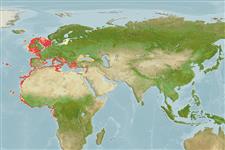| Native range | All suitable habitat | Year 2100 |

|
| Dasyatis pastinaca AquaMaps Data sources: GBIF OBIS |
Human uses
Fisheries: commercial; gamefish: yes
Phylogenetic diversity index
(Ref. 82805)
PD50 = 0.5002 many relatives (e.g. carps) 0.5 - 2.0 few relatives (e.g. lungfishes)
Trophic Level
(Ref. 69278)
4.1 ±0.63 se; Based on food items.
Resilience
(Ref. 69278)
Very Low, minimum population doubling time more than 14 years (Fec=4-7)